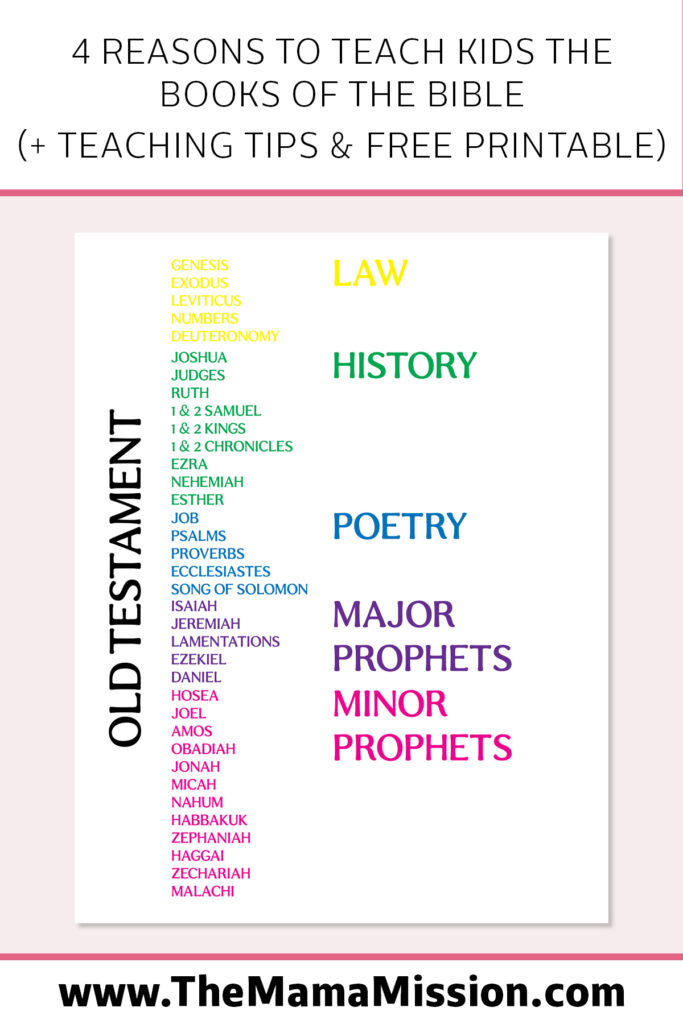
First, to form a foundation of familiarity with the Bible.
In other words, it is important to teach kids the books of the Bible to familiarize kids with the Bible, even if it is just the first step of becoming familiar with how you say the names of the books of the Bible. This is one of the first steps of teaching them about God’s Word.
Second, to prepare kids for finding verses in the Bible.
If I asked you why you should teach your kids the books of the Bible, this is likely the first reason you might think. It is an obvious purpose. By teaching kids the order of the books of the Bible even before they can read, you are preparing them for a life of ease in the basics of learning about the Bible. Not knowing the order of the books can be a frustrating stumbling block to Bible study. By engraining the simple order of the books, you are removing the stumbling block before it even forms.
Third, to provide kids with the basic framework of the Bible.
A child who knows the books of the Bible is prepared to understand more about the framework of the Bible. For example, knowing the books of the Bible helps in the understanding of the New Testament and Old Testament divisions. It also helps with the divisions within the Old Testament (books of law, poetry, etc.) and within the New Testament (gospel accounts, history, epistles). This framework also allows children to be able to tell the Old Testament history followed by Christ’s time on earth and finally through the establishment of the church. Although the Bible is not arranged strictly chronologically, knowing the books of the Bible is the first step in understanding the Bible’s framework.
Fourth, to prepare kids for serious Bible study as they mature.
If you want to prepare kids to be serious students of God’s Word as they mature, this is one of the foundational places to begin. Learning the books of the Bible is the first small step for a child to become someone who is like the man described in Psalm 1:1-3, a man who loves God’s Word and is blessed by living according to it.
1 Blessed is the man
Psalm 1:1-3 (NKJV)
Who walks not in the counsel of the ungodly,
Nor stands in the path of sinners,
Nor sits in the seat of the scornful;
2 But his delight is in the law of the Lord,
And in His law he meditates day and night.
3 He shall be like a tree
Planted by the rivers of water,
That brings forth its fruit in its season,
Whose leaf also shall not wither;
And whatever he does shall prosper.
How to Teach Kids the Books of the Bible
I employ two primary methods for teaching kids the books of the Bible: through song and through recitation. Both methods are quick, requiring only a few minutes every day to memorize the books of the Bible.
Teaching Through Song
Songs are often a great choice when teaching memorization, so naturally, learning the books of the Bible through song makes sense. There are songs for both the Old Testament books as well as the New Testament books. Although I greatly appreciate learning the books of the Bible through song, there are a couple of drawbacks.
First, I (personally) find the song for the Old Testament (at least the version I am familiar with) difficult to follow and confusing. The way the tune repeats makes it easy to flip the order of the books around which defeats the purpose in the first place. Although we sing the New Testament song at home, we do not sing the Old Testament song for those reasons. The second drawback to learning the books of the Bible through song (or only through song) is the dependence on singing the song to find the books. Even as a young adult I found I would have to “sing the song” to find books of the Bible because that is the way I had stored the information in my head.
Teaching Through Recitation
The second method of teaching the books of the Bible that I use with my kids (and my preferred way) is recitation. This sounds really boring (especially when compared to song), but there are lots of ways to make this process fun and engaging. Learning the order of the books of the Bible does not rely on remembering a tune, but rather remembering relational order. I think of it more like knowing automatically that the letter “T” comes after the letter “S” in the alphabet (although this might be a bad example since so many people also rely on the alphabet song, haha).
So, how do you teach kids the books of the Bible using recitation? This is largely up to you and depends greatly on the age of your kids. If you are starting young, I’d recommend starting by having the child repeat each book after you so that they first become familiar with the actual names of the books. Then, you can progress to saying a few books in order at a time, and having them say the books along with you. Working in small sections, you may say a few of the books, and then have them “fill-in-the-blank” with the next verse.
If your kids are older, you can simply start by saying all the books of the Bible in order together. If they can read, they can read the books along with you as you say them out loud. By repeating this process regularly (I recommend at least five days a week in the beginning), kids will quickly pick up on the order.
Once the kids have picked up on the order, you can switch up the practice by playing games with them. For instance, if you have more than one child, you can go around in a circle with each child saying the next book in order. My kids love to play a mixed-up version of this where I randomly point to a child and they are required to say the next book in order. Remember, this doesn’t have to take a long time, and the regular practice of the order of the books will benefit them for a lifetime of Bible study.
Here’s a video of Annie (at a little over four years old) reciting the Old Testament books. She doesn’t get it 100% perfect, but it shows that even from a young age the order of the books can be learned.
How to Download the Free Books of the Bible Printable Posters
Click the link below to download the free books of the Bible printable posters. These printable posters are available in both letter and A4 sizes. If the file does not open in a new window, right-click the link and choose “Save as” to save the file to a specific location on your computer.

 The Purpose of The Mama Mission
The Purpose of The Mama Mission